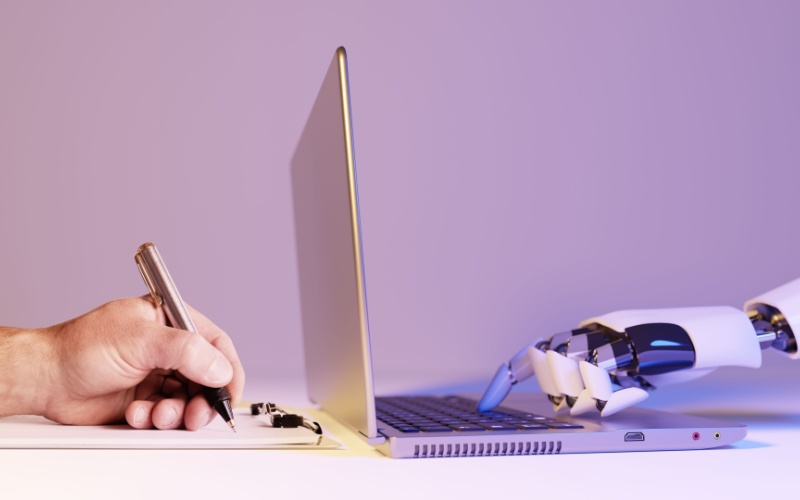Automation brings undeniable benefits. Repetitive tasks are completed with lightning speed and flawless accuracy, freeing up human resources for more complex endeavours. Customer service chatbots can handle routine enquiries, while AI-powered algorithms personalise product recommendations. These advancements streamline processes and enhance productivity.
Francoise Gelbard, Co-Founder and Head of Enterprise Sales for HumanableCX, comments, “Automation can result in significant ROI, efficiencies and cost savings for organisations, whilst creating fast, frictionless signup, purchase, onboarding and renewal journeys for customers. However, traditional text-based chatbots cannot convey empathy and are lacking the human touch”.

Overreliance on technology, however, can lead to a sterile and impersonal experience. Complex issues requiring critical thinking, empathy, and social skills are often beyond the capabilities of machines. A frustrated customer seeking a solution might find themselves lost in a labyrinth of automated menus, yearning for a human voice on the other end of the line.
“The abandonment rate for online product enquiry and purchase (with no guided assistance) stands as high as 84%, according to one Gartner survey. A big reason for the abandonment rate is that customers feel left to fend for themselves on websites, with no face-to-face dynamic, and no compassion or human connection to walk them through their interaction”, says Gelbard.
While automation can streamline some tasks, it can also create delays if human intervention is ultimately needed. Customers may feel abandoned if they have to wait a long time for a response or resolution, especially for urgent issues. Automated systems can sometimes malfunction or misunderstand customer enquiries. This can lead to frustrating experiences where customers have to repeat themselves or get stuck in a loop of irrelevant responses.

Automation can be a powerful tool, but it can also backfire if not implemented thoughtfully. It can take choice away from customers with how and when they interact with a brand. Luke Jamieson, CX and Future of Work Thought Leader, reflects on a recent experience, “I recently received a call from a company following up on an online enquiry. The voice at the end of the call had all the signs that it was a real person, natural pauses, filler words and sounds like “um” and “ah”, and there was background contact centre noise. For about three minutes we interacted and it was only when it got to the booking, did it all fall over. I then questioned if it was a bot that I was talking to and it was”.
“There are some obvious cost benefits of automation but when disclosure and choice are removed from the customer you erode confidence because confidence is simply a combination of trust plus autonomy. Two things that you don’t want to lose as a brand and from your customers”.
The irreplaceable power of human connection
Humans crave connection. Empathy, the ability to understand and share the feelings of another, is a cornerstone of successful human interaction. In situations requiring emotional intelligence or creative problem-solving, human intervention remains essential. A skilled customer service representative can not only solve a problem but also leave a lasting positive impression, fostering brand loyalty. Similarly, a team leader’s ability to motivate and inspire employees can significantly impact morale and productivity.
Jamieson cautions, “In a State of the Nation report last year in Australia, it found that one in three Aussies are lonely. The need for human connection is real with the operative word being connection. Simply being around people does not mitigate the feeling of loneliness. The more we replace opportunities for human connection the worse this statistic could become. Replacing human interaction also has a big impact on social skills. If the epic rise in TikTok and the pandemic weren’t enough to destroy our ability to connect with others on a human level then AI replacing human interaction might just be the nuke to do so”.
In terms of CX, Jamieson adds, “If brand impact is driven by trust and trust is driven by connection then the role of CX to make that connection is critical. CX practitioners will need to work out very quickly who will play what role in building connections. AI or a human”.
Finding the sweet spot: Technology as a force multiplier
The key lies not in replacing human interaction, but in leveraging technology to enhance it. Imagine a customer service representative armed with an AI-powered knowledge base, allowing them to provide faster and more accurate solutions. Envision an employee empowered with productivity tools that streamline workflows and free them for more strategic tasks.
Gelbard advises, “The key to thriving in a digital customer service landscape lies in leveraging rich customer data. This empowers businesses to deliver personalised, real-time information and calls to action throughout the entire customer journey – from acquisition and onboarding to claims and retention. But personalisation shouldn’t come at the expense of scale. The ideal solution is one that’s both human-centric and infinitely scalable”.
The future belongs to those who can harness the power of technology to amplify the human experience. Customer service chatbots can become the first line of defense, addressing simple inquiries and directing complex issues to human representatives. Data analysis tools can provide managers with actionable insights to make informed decisions regarding employee engagement and well-being.
The impact of AI on work goes far beyond automating tasks. It forces us to rethink how we structure jobs entirely. “Traditionally”, says Jamieson, “roles were built around basic tasks and working hours. But with AI handling many of these tasks, we need to design positions that contribute to a company’s bigger mission and purpose. This shift aligns perfectly with what employees increasingly value: meaningful work that makes a difference and connects to their personal goals”.
“The pandemic further fuelled the desire for autonomy and flexibility. AI can be a powerful tool in providing both, empowering employees to focus on higher-level contributions”.
The human-machine symphony: A Collaborative Future
As technology continues to evolve, the future of human-machine interaction promises a collaborative symphony. Machines will handle the heavy lifting, freeing humans to focus on creativity, innovation, and emotional intelligence. The ideal scenario isn’t humans versus machines, but humans and machines working in tandem, each playing a vital role in creating a superior and more fulfilling experience for all. By embracing this collaborative approach, we can ensure that technology continues to augment our humanity, not diminish it.
But as Jamieson points out, this symphony may entail a thorough evaluation of current social norms and working practices, “The 8-hour workday may be on the chopping block as the next big social norm to fall. With AI taking over routine tasks, businesses and society at large need to re-evaluate the link between hours worked and value delivered”.
“Instead of clinging to the traditional 8-hour model, a shift towards measuring impact becomes crucial. This means focusing on what employees achieve rather than the time they spend at their desks. This aligns perfectly with a growing desire for work-life balance and a sense of purpose in one’s career”.The focus on upgrading CX technology and digitising interactions is at an all-time high. Companies are leveraging customer data to craft personalised digital journeys. Gelbard concludes, “With this automation surge, the need for human connection in customer engagement has never been greater. The goal isn’t to replace humans with robots, but to use technology to automate repetitive tasks and personalise interactions at scale.”

